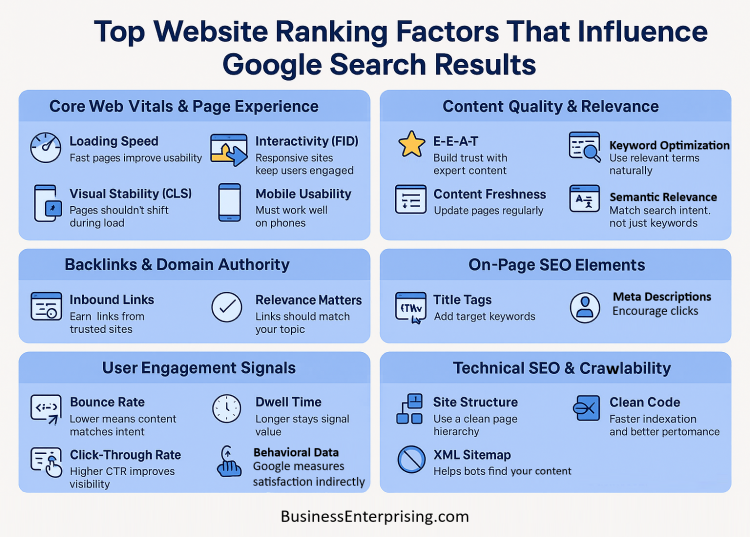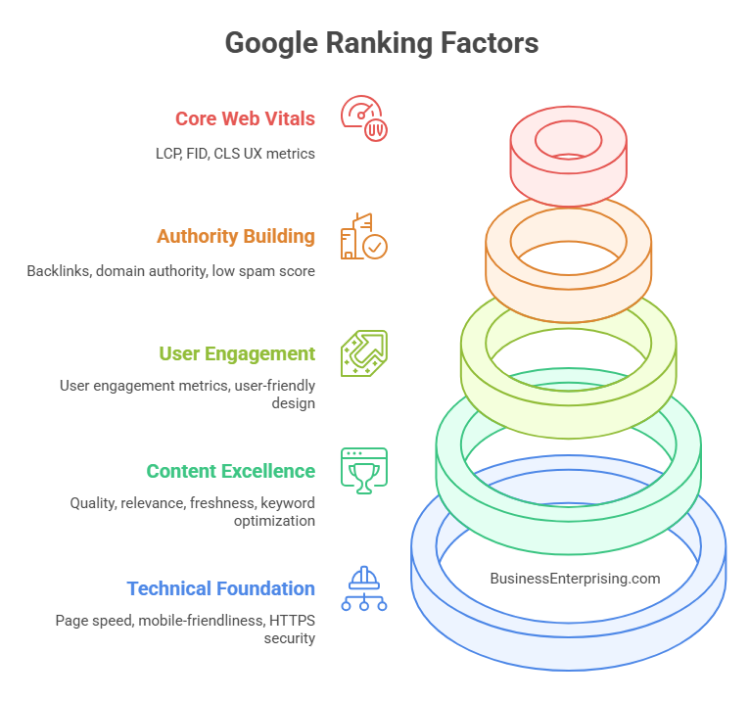 Getting your website to rank on Google takes more than just publishing content. You need to understand website ranking factors and how they work. These are the signals Google uses to decide where your site should appear in search results. Some are visible to users. Others happen behind the scenes but still influence your position.
Getting your website to rank on Google takes more than just publishing content. You need to understand website ranking factors and how they work. These are the signals Google uses to decide where your site should appear in search results. Some are visible to users. Others happen behind the scenes but still influence your position.
Search engines look for quality content, smart structure, and good user experience. Therefore, you need to give attention to both content and technical setup. Additionally, Google tracks how people interact with your site. That means things like bounce rate and time on page matter.
You might think rankings are all about keywords. However, modern algorithms go far beyond simple word matching. They evaluate meaning, trust, speed, and usability. Therefore, it’s not just what you say, but how well you present it.
Building a strong online presence takes time. But when you focus on the right areas, your progress becomes more consistent. Additionally, better rankings bring more visibility, which often means more leads and sales. That’s why it pays to do things the right way from the start. If you’re working to improve your site, this is where to begin. Understand what Google wants. Then apply those insights to your pages. Step by step, you’ll begin to see results.
Core Web Vitals and Page Experience
Core Web Vitals are performance signals that Google uses to measure how users experience your site. These signals directly affect how your site ranks. They include loading speed, interactivity, and visual stability. Each one plays a role in how usable your website feels to your visitors.
First, let’s talk about loading speed. If your pages take too long to load, users will leave quickly. Google notices that. Fast load times create a better experience and improve how search engines view your site. Therefore, faster pages usually get better rankings.
Interactivity, measured by First Input Delay (FID), tracks how quickly your site responds to clicks or taps. If users have to wait, they get frustrated. Google sees this as a negative experience. So, it rewards sites that respond quickly to user actions.
Next is visual stability. This is measured by Cumulative Layout Shift (CLS). Unexpected movements on a page, like buttons shifting during load, disrupt the user experience. Therefore, stable layout behavior is a positive ranking signal.
Additionally, your website must work well on mobile devices. Google now evaluates the mobile version of your site first. If mobile usability is poor, your rankings will suffer. Most traffic comes from phones, so mobile experience matters more than ever.
Finally, using HTTPS helps keep your site secure. Google favors secure websites over those without encryption. This small factor can tip the scale in competitive searches.
When you think about website ranking factors, user experience plays a central role. Therefore, Core Web Vitals and page experience are not optional. They are part of how Google decides where your site should appear. You can’t afford to overlook them.
Content Quality and Relevance
When it comes to website ranking factors, content quality is a major piece of the puzzle. Google wants to show users content that is helpful, clear, and accurate. That’s why it pays close attention to the E-E-A-T framework. This stands for experience, expertise, authoritativeness, and trustworthiness.
Experience reflects how familiar the writer is with the topic. Google prefers content written by people who’ve actually done the thing they’re writing about. Expertise comes next. Your content needs to show that the writer understands the subject well. Therefore, it should avoid vague statements or generic advice. Authoritativeness looks at the reputation of your site and the person behind the content. If others trust your voice, so will Google. Trustworthiness ties everything together. Therefore, it helps to be transparent and avoid misleading claims or exaggerated language.
However, content quality doesn’t stand on its own. You also need to focus on keyword optimization. That means using words and phrases your audience is actually searching for. But don’t stuff them in. Use them naturally, in ways that help the reader. Additionally, related terms help Google understand your topic better. Freshness matters too. Content that’s outdated can slip in rankings. Therefore, update your pages regularly to reflect the most current information. Google tends to favor timely, relevant content.
Finally, relevance is evaluated semantically. Google doesn’t just match keywords anymore. It uses context to understand meaning. Therefore, your content should answer real questions and stay on topic throughout. Keep your content clear, accurate, and helpful. That’s what Google is looking for. And that’s what builds long-term trust with your audience.
Backlinks and Domain Authority
Backlinks are one of the oldest and most consistent website ranking factors. They act like votes of confidence for your site. When trusted websites link to your content, Google sees that as a signal of quality and authority. Therefore, it rewards you with better visibility in search results.
However, not all backlinks carry the same weight. A single link from a respected, high-authority site can do more than dozens of random ones. Google looks at where the link comes from, not just how many you have. Therefore, quality always matters more than quantity.
Additionally, relevance plays a role. If the linking site covers similar topics, the backlink helps even more. But if the site is off-topic or spammy, the link may be ignored or even hurt your rankings. So it’s important to focus on earning links from sites that align with your subject.
You can build links in many ways. Some happen naturally when your content gets noticed. Others come from partnerships, mentions, or outreach. However, buying links or using shady tactics often backfires. Google is smart enough to spot manipulation and may penalize your site.
Domain authority is another factor worth noting. It’s not a metric Google uses directly, but it reflects how trustworthy your site appears to others. If your domain consistently earns quality backlinks, your overall reputation improves. Therefore, future content may rank faster and higher.
When it comes to website ranking factors, backlinks still carry weight. But smart link building focuses on trust, relevance, and long-term credibility.
On-Page SEO Elements
On-page SEO is about helping both users and search engines understand your content. It’s one of the most direct website ranking factors. When done right, it improves both visibility and usability.
Start with your title tag. This is the first thing users and search engines see. Therefore, it should include your main keyword and clearly describe the page. Next is the meta description. It doesn’t directly affect rankings, but it influences click-through rates. So it should be clear, relevant, and appealing.
Headers help break up your content and show structure. Use one H1 per page and break sections with H2s or H3s. Additionally, headers should include related keywords when possible. This helps Google understand your content’s hierarchy and main ideas.
Images also play a role. Every image should have alt text that describes the content. This improves accessibility and helps with image search traffic. Therefore, don’t skip this step, even if it feels minor.
Internal linking connects your pages and helps users find related content. It also passes link authority across your site. Therefore, be intentional with your links and use descriptive anchor text.
Finally, schema markup gives search engines extra information. It helps them better understand your content type, like reviews or FAQs. Additionally, it can increase your chances of showing up with rich results. When you’re thinking about website ranking factors, on-page SEO deserves close attention. It gives you control over how your content is presented, both to people and to search engines.
User Engagement Signals
User engagement signals help Google understand how visitors interact with your site. These signals often reflect how useful your content is. When users stay, click around, and come back, that tells Google your site is worth showing.
Bounce rate is the percentage of users who leave after viewing just one page. A high bounce rate might mean your content missed the mark. However, it could also mean the user got what they needed fast. Therefore, bounce rate should be viewed alongside other data.
Dwell time tracks how long users stay on a page before returning to search results. Longer dwell time usually means the content held their attention. Therefore, improving readability and relevance can help you keep users longer.
Click-through rate, or CTR, is another key metric. It tells you how many people clicked your result after seeing it. A high CTR suggests your title and description matched what users wanted. Additionally, it helps signal that your content fits the search intent.
Google also pays attention to repeat visits and time on site. If users return or view more pages, your site appears more trustworthy. Therefore, clear navigation and internal links can help guide users deeper. These behaviors influence how your site performs in search results. Google wants to show content that people actually find useful. Therefore, user engagement acts as a feedback loop for ranking performance. When you look at website ranking factors, don’t ignore behavior. What people do on your site tells Google what your content is worth.
Technical SEO and Crawlability
Technical SEO makes it easier for search engines to access, read, and index your site. These behind-the-scenes elements affect visibility. While users may not see them, Google definitely does. That’s why technical setup is one of the core website ranking factors. Your site structure should be simple and logical. Pages need to be organized in a way that search engines can follow. Therefore, a clear hierarchy with parent and child pages helps Google understand your content. Additionally, clean internal linking supports this structure.
An XML sitemap lists the pages you want Google to index. It acts like a roadmap for search engines. Therefore, it should be updated regularly and reflect your active content. Without it, some pages may be missed. The robots.txt file tells search engines what not to crawl. It helps conserve crawl budget by blocking duplicate or unimportant pages. However, use it carefully so you don’t accidentally hide important sections.
Canonical tags tell Google which version of a page is the original. This helps prevent duplicate content issues. Therefore, every page with similar content should use canonicals to point to the preferred version.
Additionally, clean and efficient code helps speed up page loading and reduces crawl errors. Cluttered code or outdated plugins can slow indexing. Therefore, use modern coding practices and avoid unnecessary scripts when possible. Technical SEO and crawlability don’t require constant tweaking. But they need to be right from the start. When you think about website ranking factors, this foundation gives your content the best chance to succeed.
Conclusion
Improving your rankings takes more than one fix. It’s the combination of many small things done well that makes a difference. Therefore, your site needs to perform, inform, and engage. That means thinking about both your users and search engines.
You don’t need to guess what works. Google has made it clear that quality, structure, and trust all play a part. Additionally, user behavior adds weight to the equation. If people stay, click, and return, that sends a strong signal. Therefore, your content must be helpful and easy to use.
Technical setup matters too. You can have great content, but if search engines can’t read it, you won’t get far. That’s why technical SEO, fast loading, and clean code all help you stand out. They might not be visible to users, but they affect everything behind the scenes.
Backlinks, structure, and smart content writing are all part of the bigger picture. Therefore, focus on building trust, improving speed, and staying relevant. Consistent effort brings the best results over time. When you understand website ranking factors, your decisions become clearer. You stop chasing quick wins and start building lasting value. It’s not about perfecting one area. It’s about improving everything that matters, little by little.




























